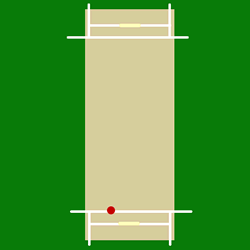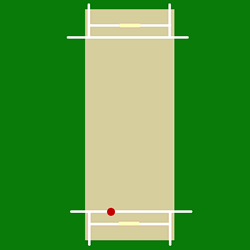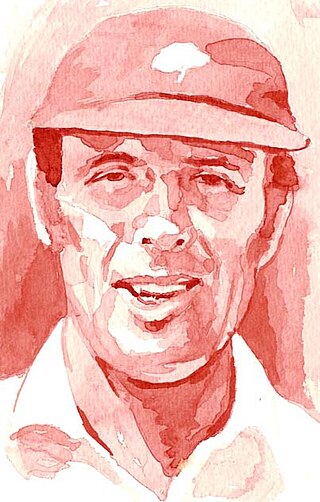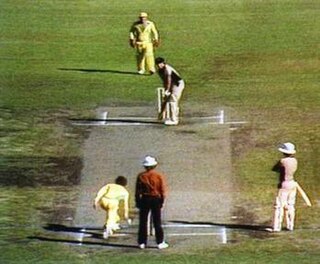Related Research Articles

Leg spin is a type of spin bowling in cricket. A leg spinner bowls right-arm with a wrist spin action. The leg spinner's normal delivery causes the ball to spin from right to left when the ball bounces on the pitch. For a right-handed batsman, that is away from the leg side, and this is where it gets the name leg break.

Off spin is a type of finger spin bowling in cricket. A bowler who uses this technique is called an off spinner. Off spinners are right-handed spin bowlers who use their fingers to spin the ball. Their normal delivery is an off break, which spins from left to right when the ball bounces on the pitch. For a right-handed batsman, this is from his off side to the leg side. The ball breaks away from the off side, hence the name 'off break'.
In the game of cricket, a googly refers to a type of delivery bowled by a right-arm leg spin bowler. It is different from the normal delivery for a leg-spin bowler in that it is turning the other way. The googly is not a variation of the typical off spin type of delivery, in that the cricket ball is presented from the bowler's hand in such a way that once the ball pitches; instead, it deviates in the opposite direction of a leg spinning type of delivery. It has also been colloquially referred to as the wrong'un, Bosie or Bosey, with the latter two eponyms referring to Bernard Bosanquet, the bowler who originally devised and began using the googly.

Bowling, in cricket, is the action of propelling the ball toward the wicket defended by a batter. A player skilled at bowling is called a bowler; a bowler who is also a competent batter is known as an all-rounder. Bowling the ball is distinguished from throwing the ball by a strictly specified biomechanical definition, which restricts the angle of extension of the elbow. A single act of bowling the ball towards the batsman is called a ball or a delivery. Bowlers bowl deliveries in sets of six, called an over. Once a bowler has bowled an over, a teammate will bowl an over from the other end of the pitch. The Laws of Cricket govern how a ball must be bowled. If a ball is bowled illegally, an umpire will rule it a no-ball. If a ball is bowled too wide of the striker for the batsman to be able to play at it with a proper cricket shot, the bowler's end umpire will rule it a wide.

Leg before wicket (lbw) is one of the ways in which a batsman can be dismissed in the sport of cricket. Following an appeal by the fielding side, the umpire may rule a batter out lbw if the ball would have struck the wicket but was instead intercepted by any part of the batter's body. The umpire's decision will depend on a number of criteria, including where the ball pitched, whether the ball hit in line with the wickets, the ball's expected future trajectory after hitting the batsman, and whether the batter was attempting to hit the ball.

Sir Geoffrey Boycott is a former Test cricketer, who played cricket for Yorkshire and England. In a prolific and sometimes controversial playing career from 1962 to 1986, Boycott established himself as one of England's most successful opening batsmen, a dogged grafter.

The wicket-keeper in the sport of cricket is the player on the fielding side who stands behind the wicket or stumps being watchful of the batsman and ready to take a catch, stump the batsman out and run out a batsman when occasion arises. The wicket-keeper is the only member of the fielding side permitted to wear gloves and external leg guards. The role of the keeper is governed by Law 27 of the Laws of Cricket.

This is a general glossary of the terminology used in the sport of cricket. Where words in a sentence are also defined elsewhere in this article, they appear in italics. Certain aspects of cricket terminology are explained in more detail in cricket statistics and the naming of fielding positions is explained at fielding (cricket).
A doosra is a particular type of delivery by an off-spin bowler in the sport of cricket. The doosra spins in the opposite direction to an off break, and aims to confuse the batsman into playing an unavoidable shot.

In cricket, batting is the act or skill of hitting the ball with a bat to score runs and prevent the loss of one's wicket. Any player who is currently batting is, since September 2021, officially referred to as a batter —regardless of whether batting is their particular area of expertise. Batters have to adapt to various conditions when playing on different cricket pitches, especially in different countries; therefore, as well as having outstanding physical batting skills, top-level batters will have quick reflexes, excellent decision-making skills, and be good strategists.
Fast bowling is one of two main approaches to bowling in the sport of cricket, the other being spin bowling. Practitioners of pace bowling are usually known as fast bowlers, quicks, or pacers. They can also be referred to as a seam bowler, a swing bowler or a fast bowler who can swing it to reflect the predominant characteristic of their deliveries. Strictly speaking, a pure swing bowler does not need to have a high degree of pace, though dedicated medium-pace swing bowlers are rarely seen at Test level in modern times.
Off theory is a bowling tactic in the sport of cricket. The term off theory is somewhat archaic and seldom used any more, but the basic tactic still plays a part in modern cricket.

In cricket, a dismissal occurs when a batter's innings is brought to an end by the opposing team. Other terms used are the batsman being out, the batting side losing a wicket, and the fielding side taking a wicket. The ball becomes dead, and the dismissed batter must leave the field of play for the rest of their team's innings, to be replaced by a team-mate. A team's innings ends if ten of the eleven team members are dismissed. Players bat in pairs so, when only one batter is not out, it is not possible for the team to bat any longer. This is known as dismissing or bowling out the batting team, who are said to be all out.
Graham Roy Dilley was an English international cricketer, whose main role was as a fast bowler. He played first-class cricket for Kent County Cricket Club and Worcestershire County Cricket Clubs, and appeared in 41 Test matches and 36 One Day International (ODIs) for the England cricket team.
In cricket, a beamer is a type of delivery in which the ball, without bouncing, passes above the batsman's waist height. This kind of delivery is dangerous, as a batter will be expecting the ball to bounce on the pitch. The failure to bounce makes it much harder to avoid the ball or to hit it with the bat. It is usually an accident caused by the ball slipping from the bowler's hands at delivery, but they have been bowled deliberately, an act highly contrary to the Laws of Cricket and the sportsmanship expected of the players.

A delivery or ball in cricket is a single action of bowling a cricket ball toward the batsman. Once the ball has been delivered, batsmen may attempt to score runs, with the bowler and other fielders attempting to stop this by getting the batsmen out. When the ball becomes dead, the next delivery can begin.
Line and length in cricket refers to the direction and point of bouncing on the pitch of a delivery. The two concepts are frequently discussed together.
The West Indian cricket team played 16 first-class cricket matches in England in 1988, under the captaincy of Viv Richards. They enjoyed considerable success during the tour, while England endured a "disastrous summer" of continuous change.

The underarm bowling incident of 1981 is a sporting controversy that took place on 1 February 1981, when Australia played New Zealand in a One Day International cricket match, the third in the best-of-five final of the 1980–81 World Series Cup, at the Melbourne Cricket Ground.
The 1993 Women's Cricket World Cup Final was a one-day cricket match between England and New Zealand played on 1 August 1993 at Lord's in London, England. It marked the culmination of the 1993 Women's Cricket World Cup, the fifth edition of the tournament. England won the final by 67 runs, clinching their second World Cup title; their first since the inaugural tournament in 1973. It was England's third appearance in a World Cup final, while New Zealand made their debut at this stage of the tournament.
References
- ↑ Greenslade, Nick (4 July 2004), "First and last: Geoffrey Boycott", The Observer
- ↑ Roebuck, Peter, England turns to a team at last, 20 November 1986, The Age (via newspapers.com)
- ↑ Selvey, Mike, Rejuvenated Dilley finds his corridor of power, 16 February 1988, The Guardian (via newspapers.com)
- ↑ Blake, Martin, Test win hopes soar, 11 July 1989, The Age (via newspapers.com)
- ↑ Thicknesse, John, Ellison is the man to put wind up Aussies, 10 May 1989, Evening Standard (via newspapers.com)